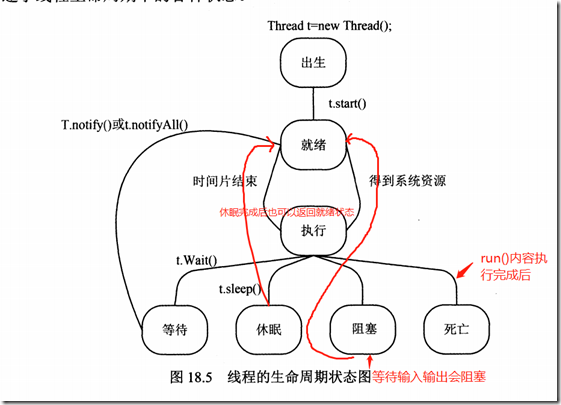5.JAVA语言基础部分—多线程
一个应用有一个进程,一个进程里可以用多个线程
1)定义
定义线程有两种方式,一是继承java.lang.Thread类,二是实现java.lang.Runnable接口。其实Thread类就是实现了Runnable接口的。
//方法一:继承Thread,并重写run()
public class OrdersThread extends Thread {
//该类实例化时并不会立即执行run(),而是在实例上调用start()才会执行
@Override
public void run() {
//需要线程执行的内容放在run方法
for (int i = 0; i < 10; i++) {
System.out.println(i);
}
}
}
//调用
public static void main(String[] args) {
OrdersThread ot=new OrdersThread();
//调用start()才真正开始线程
ot.start();
}
方法二:
//方法二实现接口Runnable
public class MyRunnable implements Runnable{
@Override
public void run() {
// 这里放需要执行的代码
}
}
// 调用
public static void main(String[] args) {
MyRunnable ta = new MyRunnable();
//通过实现Runnable接口方式,需要使用Thread实现来启动
Thread thread1 = new Thread(ta);
thread1.start();
}
方法三:Runnable方式还可以通过匿名类的写法实现
public static void main(String[] args) {
//匿名类实现的方式,匿名类实现接口Runnable
Thread thread2=new Thread(new Runnable() {
@Override
public void run() {
//需要执行的代码
}
});
}
2)线程生命周期
Thread.sleep(毫秒值):进入休眠,单位毫秒。线程不会释放对象锁,不让出系统资源,占用着。直接使用Thread类调用sleep,不用实例。谁调用谁睡觉去,即使在当前线程调用别的线程的sleep,睡觉的不是当前线程,其他线程不受影响。sleep的唤醒要等时间到了自动醒过来,如果时间不到只能调用它的实例的interrupt()强行中断。
wait():也是等待,一般不需要指定时间,需要使用notify()/notifyAll()来唤醒。它跟sleep不同,wait是释放对象锁的,不占资源,一般是用到同步模块(synchronized)中去。如下面所示,也有多线程同步的写法;
public class MyRunnable implements Runnable {
private static String flag="";
@Override
public void run() {
//多线程同步
//这里可以定义一个变量,或者使用当前类this,或空格“” 都可以
synchronized (flag) {
//这里notify()是唤醒当前MyRunnable的上一个实例继承执行(上次实例中wait()后面的代码继承执行)
//这里notifyAll()是唤醒当前MyRunnable的【所有所有所有】实例中有wait()的实例继承执行
//只能在当前的run调用notity,其它地方行
flag.notify();
for (int i = 1000; i < 1100; i++) {
if (i == 1050) {
try {
System.out.println("MyRunnable暂停了");
flag.wait();
} catch (InterruptedException e) {
e.printStackTrace();
}
}
System.out.println(i);
}
}
}
}
3)线程加入
有两个线程A、B,在执行A时某一步骤时要先让B执行完后再继续执行A,可以使用join()
package com.test;
import java.lang.annotation.Annotation;
import java.lang.reflect.Constructor;
import java.util.ArrayList;
import java.lang.reflect.*;
public class Main {
//定义未赋值的变量放在外面
private static Thread a;
private static Thread b;
public static void main(String[] args) {
a = new Thread(new Runnable() {
public void run() {
for (int i = 10; i < 20; i++) {
try {
Thread.sleep(100);
print(i);
if (i == 12) {
//到此处时,只有b完成后才会继续往下走
b.join();
}
} catch (InterruptedException e) {
e.printStackTrace();
}
}
}
});
a.start();
b = new Thread(new Runnable() {
public void run() {
for (int i = 30; i < 40; i++) {
try {
Thread.sleep(100);
} catch (InterruptedException e) {
e.printStackTrace();
}
print(i);
}
}
});
b.start();
}
}
4)线程中断
方法一:在线程继承类或实现Runnable接口的类里定义一个变量,然后在run()处判断该变量值为多少时就使用break;退出。该方法有限制,当线程里使用了sleep()或wait()后就无法退出了,此时应使用方法interrup()退出。
方法二:强行中断线程使用interrup(),调用线程的实例的interrup()方法,线程执行处就会抛出异常InterruptedException,使用try catch捕获使用break退出即可。
public class OrdersThread extends Thread {
@Override
public void run() {
for (int i = 0; i < 10; i++) {
if(i==5)
try {
Thread.sleep(1000);
} catch (InterruptedException e) {
//只要在run()里使用try catch捕获InterruptedException异常,然后使用break处理并退出了
System.out.println("强行退出了");
break;
}
System.out.println(i);
}
}
}
OrdersThread t3=new OrdersThread(); t3.start(); t3.interrupt();//实例里强行退出
5)线程优先线
线程优先级有常数:1-10,默认为5
使用setPriority(1~10的整数)
OrdersThread t3=new OrdersThread();
//注意值的范围是1-8
t3.setPriority(8);
//也可以使用预先定义的枚举指定
//t3.setPriority(Thread.NORM_PRIORITY);
t3.setName("线程名称");//这里设置线程名称的写法
//最后才能start
t3.start();
6)线程同步
public class MyRunnable implements Runnable {
@Override
public void run() {
// Object可以是任何,一般是定义一个静态变量,或者当前类实例
synchronized (Object) {
// 需要步的代码
for (int i = 1000; i < 1100; i++) {
System.out.println(i);
}
}
}
}
线程同步方法
//同步方法使用synchronized修饰
public synchronized String getName() {
return "";
}




 浙公网安备 33010602011771号
浙公网安备 33010602011771号